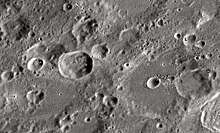Zagut (crater)
Zagut is a crater located in the heavily impacted southeast sector of the Moon. It is almost surrounded by other named craters, with Wilkins to the northwest, Lindenau to the east, Rabbi Levi in the southeast, and Celsius to the southwest. It is named after Spanish astronomer and rabbi Abraham Zacuto.[1]
 Lunar Orbiter 4 image | |
| Coordinates | 32.0°S 22.1°E |
|---|---|
| Diameter | 84 km |
| Depth | 3.2 km |
| Colongitude | 339° at sunrise |
| Eponym | Abraham Zacuto |
The rim of Zagut is worn and irregular, especially to the north and east. The east rim is overlain by Zagut E, a crater with an irregular and flat floor. The floor of Zagut itself is also relatively flat, and the center is occupied by the crater Zagut A instead of a peak.
Satellite craters

Zagut crater and its satellite craters taken from Earth in 2012 at the University of Hertfordshire's Bayfordbury Observatory with the telescopes Meade LX200 14" and Lumenera Skynyx 2-1
By convention these features are identified on lunar maps by placing the letter on the side of the crater midpoint that is closest to Zagut.
| Zagut | Latitude | Longitude | Diameter |
|---|---|---|---|
| A | 32.0° S | 21.6° E | 11 km |
| B | 32.1° S | 18.7° E | 32 km |
| C | 30.8° S | 18.5° E | 24 km |
| D | 31.4° S | 19.3° E | 16 km |
| E | 31.7° S | 23.1° E | 35 km |
| F | 30.2° S | 17.5° E | 8 km |
| H | 29.9° S | 20.7° E | 8 km |
| K | 31.7° S | 22.2° E | 7 km |
| L | 30.3° S | 22.1° E | 12 km |
| M | 30.8° S | 22.9° E | 6 km |
| N | 31.2° S | 23.5° E | 9 km |
| O | 33.0° S | 16.7° E | 11 km |
| P | 32.4° S | 17.4° E | 14 km |
| R | 30.8° S | 20.7° E | 4 km |
| S | 33.3° S | 22.6° E | 7 km |
gollark: And yet inferior to the resplendent glory of Rust.
gollark: As such, things.
gollark: The interpreter has one global lock for all data structures.
gollark: Threads *work*, they just aren't faster.
gollark: The GIL.
References
- "Zagut (crater)". Gazetteer of Planetary Nomenclature. USGS Astrogeology Research Program.
- Andersson, L. E.; Whitaker, E. A. (1982). NASA Catalogue of Lunar Nomenclature. NASA RP-1097.CS1 maint: ref=harv (link)
- Bussey, B.; Spudis, P. (2004). The Clementine Atlas of the Moon. New York: Cambridge University Press. ISBN 978-0-521-81528-4.CS1 maint: ref=harv (link)
- Cocks, Elijah E.; Cocks, Josiah C. (1995). Who's Who on the Moon: A Biographical Dictionary of Lunar Nomenclature. Tudor Publishers. ISBN 978-0-936389-27-1.CS1 maint: ref=harv (link)
- McDowell, Jonathan (July 15, 2007). "Lunar Nomenclature". Jonathan's Space Report. Retrieved 2007-10-24.CS1 maint: ref=harv (link)
- Menzel, D. H.; Minnaert, M.; Levin, B.; Dollfus, A.; Bell, B. (1971). "Report on Lunar Nomenclature by the Working Group of Commission 17 of the IAU". Space Science Reviews. 12 (2): 136–186. Bibcode:1971SSRv...12..136M. doi:10.1007/BF00171763.CS1 maint: ref=harv (link)
- Moore, Patrick (2001). On the Moon. Sterling Publishing Co. ISBN 978-0-304-35469-6.CS1 maint: ref=harv (link)
- Price, Fred W. (1988). The Moon Observer's Handbook. Cambridge University Press. ISBN 978-0-521-33500-3.CS1 maint: ref=harv (link)
- Rükl, Antonín (1990). Atlas of the Moon. Kalmbach Books. ISBN 978-0-913135-17-4.CS1 maint: ref=harv (link)
- Webb, Rev. T. W. (1962). Celestial Objects for Common Telescopes (6th revised ed.). Dover. ISBN 978-0-486-20917-3.CS1 maint: ref=harv (link)
- Whitaker, Ewen A. (1999). Mapping and Naming the Moon. Cambridge University Press. ISBN 978-0-521-62248-6.CS1 maint: ref=harv (link)
- Wlasuk, Peter T. (2000). Observing the Moon. Springer. ISBN 978-1-85233-193-1.CS1 maint: ref=harv (link)
| Wikimedia Commons has media related to Zagut (crater). |
This article is issued from Wikipedia. The text is licensed under Creative Commons - Attribution - Sharealike. Additional terms may apply for the media files.